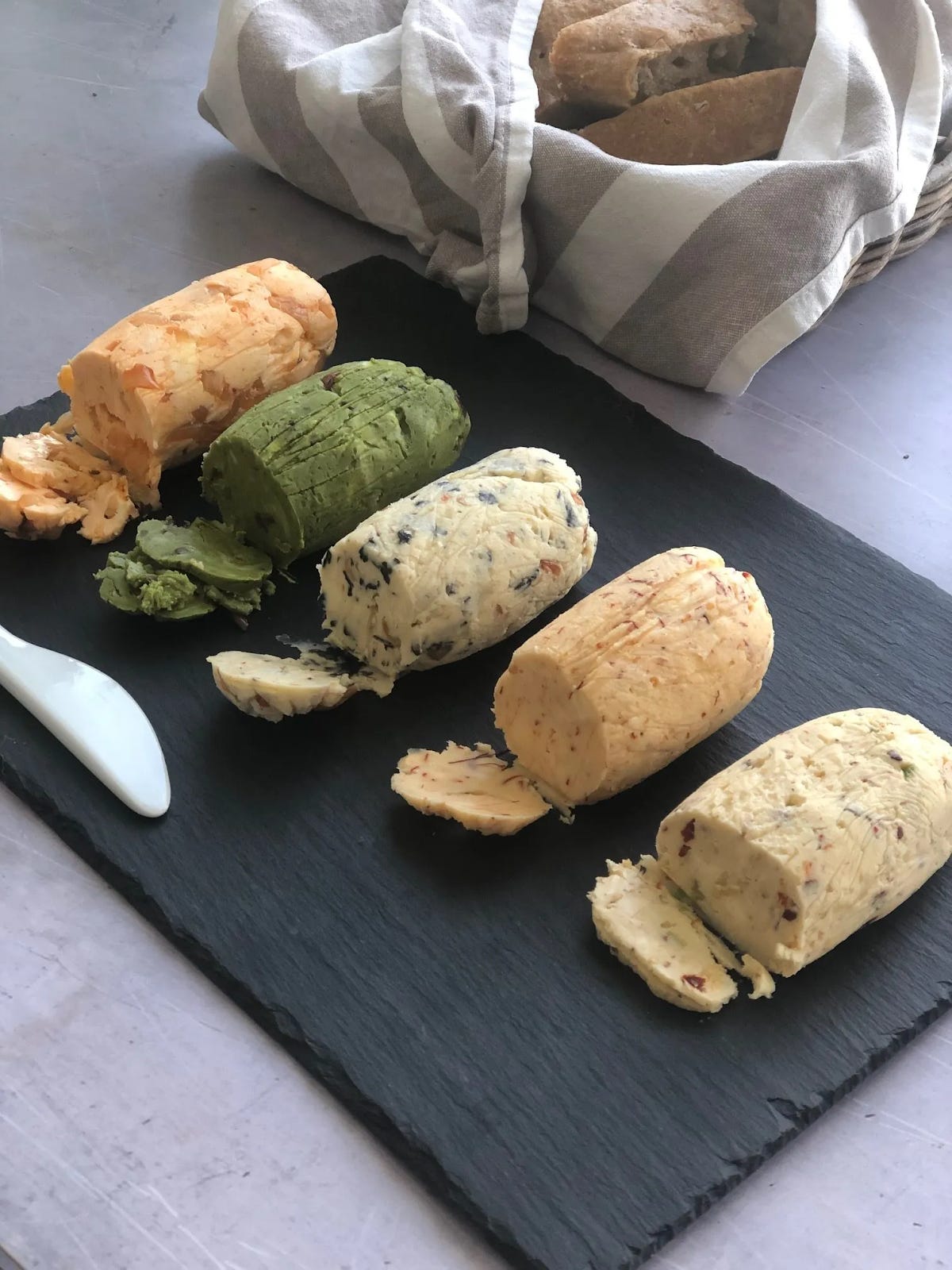How we pick our ingredients #2: Butter
The secret behind that perfect crunch
Not too long ago, we chatted about how we select the eggs we use in our delicious egg tarts. This time, we will talk about the magical ingredient that gives the egg tart shells its aromatic flavor and crispy crunch - butter! Butter is what lifts the aroma in food, and gives pastries the beautiful flaky layers, that delicious crunch. Mmmmmm…croissants anyone?
In this post, we will cover:
The difference between salted and unsalted butter
How fat content matters and butters have different shades of yellow
Where we source our butter
Other types of butter
🥐 What is the difference between salted and unsalted butter?
This is not a trick question! Indeed as the name suggests, unsalted butter has no salt in it, whilst salted butter does. While both kinds are versatile, there are reasons for why you would want to use one instead of another.
🥐You can control the salt with unsalted butter.
Recipes call for both salt and butter, so why not use unsalted butter right? The perks of using unsalted butter is that you can control the exact amount of salt you add. With salted butter however, the salt content varies between different brands, ranging from 1.25 to 1.75 percent of the total weight. It is not clear how much salt we are adding to our mixture as a result.
Salted butter is ideal and convenient if you simply wish to enhance the flavor in your savory dishes, such as when sautéing vegetables, making sauces, buttering your Thanksgiving turkey or cooking scrambled eggs.
But if you are baking, unsalted butter would give you better control of how much salt you add. If you are also watching your sodium intake, maybe unsalted butter would be a better option too.
🥐Unsalted butter is fresher.
Salt acts as a preservative, and so salted butter has a longer shelf life by three to four months.
🥐Unsalted butter has lower water content.
This can be quite important in baking. When baking bread and pastries, water content affects how the gluten forms in your dough. Gluten is what holds the dough together. If there is extra water content, this can cause the dough to be too sticky, which makes it difficult for the shape to hold properly. Because of this, unsalted butter is a better choice for baking so you can control both the salt and water you add.
🥐Does fat content matter?
The amount of fat in the butter you buy depends on where it is from! Did you know that there is a difference between American butter and European butter?
According to USDA standards, butter sold in the US must have at least 80% of butterfat content, whilst in Europe, this benchmark is set at 82%. European butter is typically cultured butter, which is fermented butter with live cultures added to it. It is churned for a bit longer, which gives it at least the high 82% butterfat content, as well as its distinct tanginess in its flavor.
Source: Epicurious
Kerrygold butter, for example, has 82% fat! There are also some brands that sell butter with fat content that is higher than that, like Minerva Diary which produces Amish butter with 85% fat in it! Amish butter is usually made by slow churning the butter in small batches. When butter is churned in large batches, air can be trapped between the butter which affects the taste and texture. Because of this, you will find slow-churned butter to be incredibly rich and creamy.
Climate, churning process and breed of cows are some of the key factors that can affect the acidity, taste, color and texture of the butter!
This percentage difference may not seem to be much. But for chefs and bakers, it makes a huge difference in terms of taste and texture. With a higher fat content, European butter is incredibly soft, richer in flavor, and pleasantly spreadable, if you prefer smearing butter on your toast.
But whether a higher butterfat content is better for baking depends on what you are trying to make. For crispy pastries like a danish or a croissant, a higher butterfat content is preferable. However, for pastries that need to be lighter and fluffier, where other flavors like the sugar should ideally stand out, butters with a lower fat content would be a better choice.
🥐Why do butters have different shades of yellow?
Some butters are a paler shade of yellow, whilst others might be a deeper shade. This is because of the feed of the cows! It is exactly like how the color of egg yolks depends on the chickens’ feed.
Cows who feed on grass will produce yellow butter, whilst cows that are pasture-raised and that feed on grains like corn, will produce a paler shade of butter. Whilst the taste between the both is subjective, we find that grass-fed butter is richer and creamier in both flavor and texture.
Grass-fed butter is also higher in omega-3 fatty acids, Vitamin A and Vitamin K, which help promote brain and heart health, vision as well as bone health respectively. Although this is exciting, we do want to note that butter has a high fat content and should not be consumed in moderation. Too much can lead to higher risks of obesity and hypertension - so a moderate, healthy diet is the way to go!
🥐Where do we source our butter?
At Marupo, we mainly source our unsalted butter from Calder Dairy, a local business that is based in Michigan. We love how transparent and community-friendly the business is, welcoming people to visit their farm in Carleton throughout the year. Just like choosing the eggs you use, it is important to know your suppliers so you can understand their facilities better, and whether the butter you use comes from happy cows! 🐄
Because the butter from Calder Dairy does not use artificial preservatives, the butter is incredibly fresh and best used within the week. We also love how the ingredient list is simple and understandable - just cream and salt. Some butters have a list of preservatives and other ingredients like citric acid, vegetable mono & diglycerides, and words that we cannot even spell or pronounce, let alone understand.
When we are able to understand every ingredient in the label, it is reassuring to at least we know what we are really eating! And that is why we love using Calder Dairy’s fresh farm butter.
🥐Wait. What about other types of butter, like ghee and compound butter?
Ghee is basically clarified butter, which is made by simmering regular butter. In this process, the mixture separates into liquid and solid components. The solid residue is discarded, and the clear liquid fat is retained. Ghee is often used in Indian cuisine, especially sweets like mysore pak and kaju katli (highly recommended by Falai).
Source: Delhi6Sweets
Meanwhile, compound butter is a delicious aromatic butter that is mixed with various herbs and spices. It is delicious as a condiment to your bread, baked potatoes, pasta, etc. You can make your own herb butter at home, like garlic herb butter!
For Asian-inspired compound butters, check out the ones featured here on Pass Me The Dimsum! You can try to make your own kimchi butter, matcha and azuki bean butter, miso butter and many more.
Source: Pass Me The Dimsum
🥐How do you use butter?
Before Falai rushes off to get a strawberry danish, let us know in the comments about any fun facts we missed out about butter, and your favorite brands. Even better, we would love to know what your favorite pastries are!










